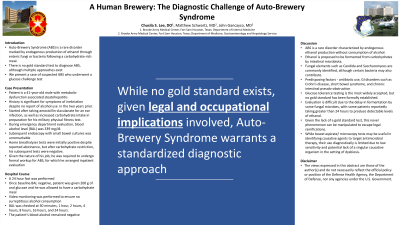Monday Poster Session
Category: Small Intestine
P3227 - A Human Brewery: The Diagnostic Challenge of Auto-Brewery Syndrome
Monday, October 28, 2024
10:30 AM - 4:00 PM ET
Location: Exhibit Hall E

Has Audio

Chusila S. Lee, DO
Brooke Army Medical Center
Fort Sam Houston, TX
Presenting Author(s)
Chusila S. Lee, DO1, John Gancayco, MD2, Matthew Schwartz, MD2
1Brooke Army Medical Center, Fort Sam Houston, TX; 2Brooke Army Medical Center, San Antonio, TX
Introduction: Auto-Brewery Syndrome (ABS) is a rare disorder marked by endogenous production of ethanol through enteric fungi or bacteria following carbohydrate-rich meals. We present a case of suspected ABS who underwent diagnostic evaluation with glucose challenge.
Case Description/Methods: A 41-year-old male with metabolic-dysfunction associated steatohepatitis was admitted for ABS workup with a glucose challenge. His history was significant for symptoms of inebriation despite lack of endorsed alcohol consumption in the two years prior. This occurred after taking amoxicillin-clavulanate for an ear infection, as well as increased carbohydrate intake in preparation for his military physical fitness test. During evaluation in the emergency department, he was found to have a blood alcohol level (BAL) of 339 mg/dl. Subsequent work-up included endoscopy with small bowel cultures being unremarkable. His home breathalyzer tests were initially positive despite endorsed abstinence, but after carbohydrate restriction subsequent tests were negative.
Prior to his glucose challenge test, he first underwent a 24 hour fast. Once baseline BAL was negative, he was given 200 g of glucose and his diet was advanced. He consented to video monitoring while inpatient. His BAL was checked at 30 minutes, 1 hour, 2 hours, 4 hours, 8 hours, 16 hours, and 24 hours. Throughout testing, his BAL was negative.
Discussion: ABS is a rare disorder characterized by endogenous ethanol production without consumption of alcohol. Ethanol is proposed to be fermented from carbohydrates by intestinal microbiota. Fungal elements such as Candida and Saccharomyces are commonly identified agents, although certain bacteria may also contribute.
Although glucose tolerance testing is the most widely accepted, no gold standard has been formally established. Evaluation is difficult due to the delay in fermentation by some fungal microbes, with some patients reportedly taking 8-24 hours or longer to produce detectable levels of ethanol. While bowel aspirate/microscopy tests may be useful in identifying causative agents to target antimicrobial therapy, their use diagnostically is limited due to low sensitivity and potential lack of a singular causative organism in the setting of dysbiosis.
A structured approach to diagnostic evaluation for this disorder is important for physicians, as the presence of ABS can have legal and occupational implications for patients. In our case we offered elective video monitoring of the patient, which was accepted.
Disclosures:
Chusila S. Lee, DO1, John Gancayco, MD2, Matthew Schwartz, MD2. P3227 - A Human Brewery: The Diagnostic Challenge of Auto-Brewery Syndrome, ACG 2024 Annual Scientific Meeting Abstracts. Philadelphia, PA: American College of Gastroenterology.
1Brooke Army Medical Center, Fort Sam Houston, TX; 2Brooke Army Medical Center, San Antonio, TX
Introduction: Auto-Brewery Syndrome (ABS) is a rare disorder marked by endogenous production of ethanol through enteric fungi or bacteria following carbohydrate-rich meals. We present a case of suspected ABS who underwent diagnostic evaluation with glucose challenge.
Case Description/Methods: A 41-year-old male with metabolic-dysfunction associated steatohepatitis was admitted for ABS workup with a glucose challenge. His history was significant for symptoms of inebriation despite lack of endorsed alcohol consumption in the two years prior. This occurred after taking amoxicillin-clavulanate for an ear infection, as well as increased carbohydrate intake in preparation for his military physical fitness test. During evaluation in the emergency department, he was found to have a blood alcohol level (BAL) of 339 mg/dl. Subsequent work-up included endoscopy with small bowel cultures being unremarkable. His home breathalyzer tests were initially positive despite endorsed abstinence, but after carbohydrate restriction subsequent tests were negative.
Prior to his glucose challenge test, he first underwent a 24 hour fast. Once baseline BAL was negative, he was given 200 g of glucose and his diet was advanced. He consented to video monitoring while inpatient. His BAL was checked at 30 minutes, 1 hour, 2 hours, 4 hours, 8 hours, 16 hours, and 24 hours. Throughout testing, his BAL was negative.
Discussion: ABS is a rare disorder characterized by endogenous ethanol production without consumption of alcohol. Ethanol is proposed to be fermented from carbohydrates by intestinal microbiota. Fungal elements such as Candida and Saccharomyces are commonly identified agents, although certain bacteria may also contribute.
Although glucose tolerance testing is the most widely accepted, no gold standard has been formally established. Evaluation is difficult due to the delay in fermentation by some fungal microbes, with some patients reportedly taking 8-24 hours or longer to produce detectable levels of ethanol. While bowel aspirate/microscopy tests may be useful in identifying causative agents to target antimicrobial therapy, their use diagnostically is limited due to low sensitivity and potential lack of a singular causative organism in the setting of dysbiosis.
A structured approach to diagnostic evaluation for this disorder is important for physicians, as the presence of ABS can have legal and occupational implications for patients. In our case we offered elective video monitoring of the patient, which was accepted.
Disclosures:
Chusila Lee indicated no relevant financial relationships.
John Gancayco indicated no relevant financial relationships.
Matthew Schwartz indicated no relevant financial relationships.
Chusila S. Lee, DO1, John Gancayco, MD2, Matthew Schwartz, MD2. P3227 - A Human Brewery: The Diagnostic Challenge of Auto-Brewery Syndrome, ACG 2024 Annual Scientific Meeting Abstracts. Philadelphia, PA: American College of Gastroenterology.
